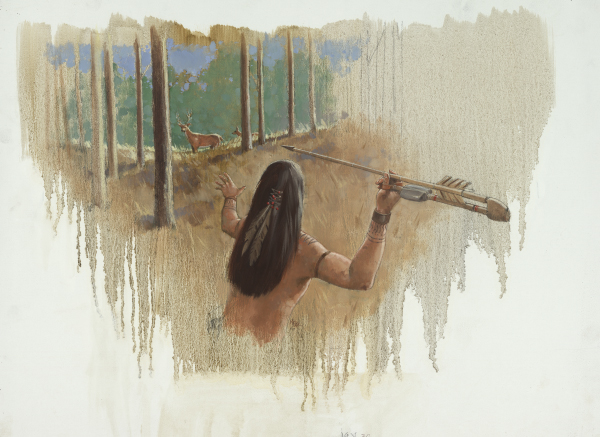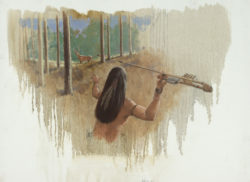San Patrice Culture
This entry covers the San Patrice culture during the Late Paleoindian and Early Archaic Periods, 8800–6000 BCE.

Courtesy of Louisiana Office of State Parks
Hunting with an Atlatl. Painting by Martin Pate
There is good evidence in Louisiana for the culture that came after Clovis, the San Patrice culture. People of the San Patrice culture moved around less than their Clovis-culture ancestors. They had less interaction with other societies, resulting in the development of regional styles of stone points. Less movement and less interaction resulted in less opportunity to obtain high-quality stone; projectile points and other stone tools were made with lower-quality, local stone. Less mobility also produced an increase in population. Larger populations living in the same place for longer periods of time produced more sites and sites that are easier to detect.
San Patrice Culture: Definition and Important Sites
In Louisiana, San Patrice is the principal culture of the Late Paleoindian and Early Archaic Periods. The culture and the very distinctive San Patrice spear point are named after a stream in DeSoto Parish. San Patrice culture sites are relatively common (compared to earlier sites), particularly in western Louisiana. The sites are typically located in upland settings and are rarely found in the river valleys. Erosion and burial beneath flood deposits may have destroyed or buried sites in the valleys.
San Patrice sites are often found along streams where chert gravel, used to make stone tools, is available. Other sites may have been located with respect to particular food resources. One of these is the John Pearce site, in Caddo Parish. The John Pearce site is located at an ecotone—a place where different environments come together—which provides easy access to a diverse set of resources. The settlement was established in an upland location with forest and prairie nearby, and it overlooks the broad floodplain of Cypress Bayou where lowland and aquatic resources were available.
The John Pearce site was investigated in the late 1960s. Excavation of 189 five-foot squares revealed the site had two activity areas. Because tool types in the areas were similar, the excavators concluded that the two areas were occupied at roughly the same time. Tools were related to hunting and butchering and included implements for cutting and scraping. Other tools were used to drill bone, antler, hide, and possibly wood. The excavators explicitly noted the absence of tools associated with “women’s activities.” The types of artifacts, along with the relatively low artifact density, a scarcity of hearths, and few other features such as traces of house posts, suggested that the areas were temporary hunting camps.
A few large blades were found at the site, but it is unclear whether these tools were produced by San Patrice or Clovis peoples. Curiously, the presence of Clovis and related points on San Patrice sites is relatively common. In most of these sites, it is difficult to determine whether there was a separate, earlier Clovis component that got mixed with the overlying San Patrice deposits, or whether the big blades were produced by San Patrice peoples. Alternatively, San Patrice people may have been collecting earlier Clovis and other large points, as curios or to use as tools.
San Patrice Culture Artifacts
San Patrice points are small, about two inches in length. The small size may have been determined in part by the size of locally available stone, which is generally found as small cobbles. Throughout most of Louisiana, San Patrice points were made in four basic shapes, called varieties: Hope, St. Johns, Dixon, and Keithville. The varieties differ in the way the base and sides of the points are formed. The varieties show a continuum from fluted and ground bases (Hope) that resemble earlier Clovis culture points, to transitional points with shallow notches on the sides (St. Johns), to forms with corner-notching (Dixon and Keithville) that are similar to later, stemmed points. These stylistic changes may be related to the introduction of the atlatl, or spear thrower, which was used with a lightweight spear (sometimes called a dart). The atlatl greatly increased the velocity and the distance that a spear could be thrown. Another point, which is distinct enough to warrant a name of its own, is the Pelican point. This unusual style is five-sided and may have been used as a knife rather than a spear point. However, its specific function is unknown.
Another distinctive San Patrice tool is the Albany side-scraper. It has a notched base like a point but is made from a flat pebble that has been worked along one side to form a large, C-shaped edge. It appears to be a multi-purpose tool used for both cutting and scraping. Whatever its function, demand for the tool was sufficient to create a specific form associated only with the San Patrice culture (although a similar implement, the Edgefield scraper, is present in Early Archaic assemblages in Florida, Georgia, and South Carolina).
Other stone tools common to the San Patrice culture include end- and more generalized side-scrapers, drills, gravers, burins, and denticulates. The latter three tools have sharp points for engraving wood and bone. Some San Patrice sites also contain a limited number of stone tools for grinding seeds and nuts. Tools made of bone, shell, or wood have not been preserved at any of the excavated sites, so archaeologists do not know if, or how, these materials might have been used.
Daily Lives and Deaths
Most San Patrice culture sites are small and have a low density of artifacts. Archaeologists believe this pattern is characteristic of small groups of people that occupied a series of different sites throughout the year. Some of these sites may have been short-term encampments used to collect specific resources. A few sites are larger and have a higher density of artifacts. These sites may have been base camps, where people spent more time. The largest sites may have been locations where many groups came together at certain times of the year.
The San Patrice culture developed at a time when the environment was changing from earlier, Ice Age conditions to a more modern landscape. Plant and animal remains have not been recovered from a San Patrice culture site in Louisiana, so information on food is limited. Research at sites in surrounding states indicates San Patrice people hunted bison in grasslands and pursued deer, fish, turtles, and rabbits in woodlands and bottomlands.
San Patrice people primarily used locally available stone for their tools, but a few artifacts are made of finer-grained, exotic stone (the finer the grain, the easier it is to work the stone). These materials indicate that, on occasion, people traveled to other areas or traded with people to acquire better-quality stone. The increasing use of local stone does indicate that people were beginning to settle down in smaller territories. The overall population density was still low, so groups did not have to compete with each other for resources. There is little evidence for significant or sustained trade, and, to date, no mound construction has been identified for this culture. There are no known San Patrice culture burials in Louisiana.
Final Thoughts
The inventory of San Patrice culture sites is growing, but more excavations are needed to better understand how the people lived and adapted to new environmental and social constraints. One thing is sure. The adaptations were quite successful. The lifestyles and toolkits that San Patrice people were developing would persist for thousands of years across many areas of Louisiana.
